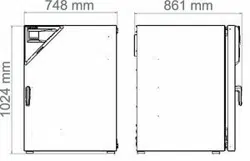Loading ...
Loading ...
Loading ...

CB-S / CB-S-UL (E7) 06/2020 page 85/119
In case of contamination of the interior by biologically or chemically hazardous material, there are two
possible procedures depending on the type of contamination and charging material.
1. Spray the inner chamber with an appropriate disinfectant.
Before start-up, the chamber must be absolutely dry and ventilated, as explosive gases may form dur-
ing the decontamination process.
2. You can sterilize the shelves in a sterilizer or autoclave.
In case of eye contact, the disinfectant spray may cause eye damage due to chemical
burns. Follow the operating instructions and safety hints labeled on the bottle of the disin-
fectant spray.
Recommended precautions: To protect the eyes use sealed protective goggles.
CAUTION
Danger of chemical burns through eye contact with the disinfectant
spray.
Eye damage. Environmental damage.
∅ Do NOT empty the disinfectant spray into drains.
Wear protective goggles.
Following frequent use of the disinfectant spray and prior to hot-air sterilization, remove any
agent remainder by using the neutral cleaning agent and then a moistened towel to avoid for-
mation of permanent residues.
After using the disinfectant spray, allow the incubator to dry thoroughly, and aerate it suffi-
ciently.
22.3 Disinfection of the CO
2
sensor
To ensure complete disinfection and proper function of the sensor, BINDER recommends a wipe disinfec-
tion of the sensor head with pure alcohol or non-corrosive alcohol-based surface disinfectants. The disin-
fectant must be non-corrosive and free of chlorine or any acid. We recommend using the disinfectant Art.
No. 1002-0022. Avoid strong shocks when handling the CO
2
sensor.
NOTICE
Danger of damage to the CO
2
sensor through improper handling (excess tempera-
ture, immersion into liquids, shocks).
Damage to the CO
2
sensor.
∅ Do NOT immerse the CO
2
sensor into liquids.
∅ Do NOT expose the CO
2
sensor to autoclaving.
∅ Do NOT expose the CO
2
sensor to hot-air sterilization.
Avoid strong shocks of the CO
2
sensor (by putting it down hard, or dropping).
Loading ...
Loading ...
Loading ...
